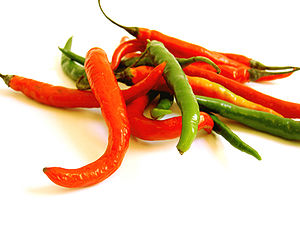Cayenne (plant)
| Cayenne | ||||||||||||
|---|---|---|---|---|---|---|---|---|---|---|---|---|

Cayenne chillies |
||||||||||||
| Systematics | ||||||||||||
|
||||||||||||
| Scientific name | ||||||||||||
| Capsicum annuum var. Acuminatum | ||||||||||||
| Fingerh. |
Capsicum annuum var. Acuminatum , often referred to as Cayenne ([ kaˈjɛn ]), is a chilli varietythat isassigned to the Capsicum annuum species. The name comes from the language of the Tupi , in the kyinha about Sharp pepper means.
Description and system
The habitus of the plants resembles that of most plants of the species Capsicum annuum . The fruits are conical-upright and sit with a broad base on the calyx. There are red and yellow varieties.
The name Cayenne has been given to several varieties over the years, some of which are now assigned to different species. A monograph on the genus Capsicum from 1898 by Henry Clay Irish , which mainly relates to cultivated peppers, describes a variety called Cayenne as Capsicum annuum conoides and the varieties Long Cayenne Red and Long Cayenne Yellow as Capsicum annuum acuminatum . The varieties he described as Capsicum annuum conoides are now mostly assigned to the species Capsicum frutescens , while the species still known today as Cayenne are listed as Capsicum annuum var. Acuminatum .
use
The best-known use of cayenne chilis is the spice powder cayenne pepper , which is obtained from the dried and ground fruits of the plant. But whole fruits are also available dried, especially because this type of chilli is well suited for drying due to its thin pericarp . The fruit is mainly used fresh in Louisiana's Cajun cuisine .
Web links
- Cayenne at pepperworld.com (German)
Individual evidence
- ^ Anton Fingerhuth: Monographia generis Capsici. Arnz, Düsseldorphii, 1832.
- ↑ Henry Clay Irish: A revision of the genus Capsicum with a special reference to garden varieties. 9th Annual Report of the Missouri Botanical Garden, 1898. Pages 53-110.
- ^ Charles B. Heiser Jr. and Barbara Pickersgill: Names for the cultivated Capsicum species (Solanaceae) . In: Taxon , Volume 18, Number 3, June 1969. Pages 277-283. doi : 10.2307 / 1218828